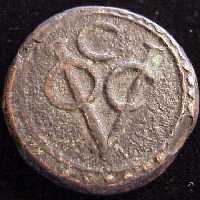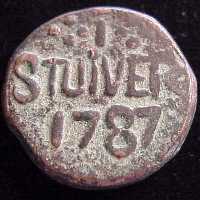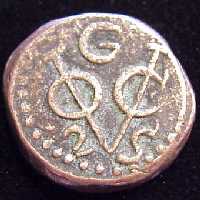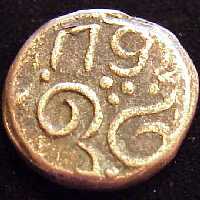Modern Fakes of Lankan coins
When coins had the same value as the metal in them, under weight or
cheaper metal contemporary counterfeits circulated and are
numismatically interesting and often collected.
However, forgeries of rare coins have also
been made in recent times to defraud coin collectors.
There are two basic classes of forgeries.
1 The cheap kind, which don't cost much to produce and sold
like souvenirs at whatever "bargain" price they can hoodwink an
ignorant tourist to pay. It is very easy to learn to
identify this junk.
2 The expensive kind made to deceive novice collectors via an
auction or a dealer. Although expensive to make, the skilled labour
needed is cheap in the developing Asian countries. They are
increasingly difficult to identify from the real items without
expensive metallurgy tests which could cost more than the coin.
If the original coin is machine struck the forger need to use similar machines
with near perfect dies to escape detection by an expert.
This is an expensive enterprise to produce the few copies that
may be slipped without notice into the coin market. Low value machine minted
coins are very unlikely to be forgeries.
However rare coins that were cast or hand stuck like with "dump coinage"
with a lots of minor variation between the dies used, is
unfortunately a market that can be exploited by the crooked.
Collectors need to be extra cautious.
In 1895 Numismatic Chronicles Col. B. Lowsley
describes
how he inserted standing advertisement in the most widely circulated
daily newspaper to buy Lankan coins. Buying at prices slightly higher
than metal value, he probably saved the destruction of many coins from
the melting pots of Jewelers, but probably motivated the cheats, to
create what he was seeking.
Lowsley felt that modern forgeries are most easy to detect. However
in 1924 Codrington Ceylon Coins and Currency (page 67) commenting on
Lowsley collection, said I quote
"It is known that not a few of the coins in this writer's collection
were spurious, and unless confirmed by finds, the authenticity of his
gold and silver pieces is open to suspicion."
Comments are also made in the even older 1907 John Still's papers in the
Journal of the Royal Asiatic Society Ceylon Branch, Vol 19 #58 161-216.
On page 164 he puts a footnote to the word "genuine" I quote
" How rare genuine specimens are I am inclined to think very few
people thoroughly recognize. Gold "Lankesvaras" and "Vijaya Bahus' are
turned out wholesale in Kandy now, and are so skillfully done that most
of them are duly absorbed into collections. The improved manufacture
of late is marked"
These quotes remind us that it was well known to the experts long time
ago, that some Lankan coins have been expertly "recreated".
A 1833 police report
describe the use of Dalipothu (Cuttle fish shell) in counterfeiting.
Uncirculated gold Kahavanu may infact be from freshly cut dies.
It is regrettable that some coin dealers feel the need to be over positive
to sell items.
So it is probably a false sense of confidence even when buying from an old
collection, or trusting any dealer's 100% guarantee of authenticity
without the expensive tests which might prove it. Fake gold coins are still
being made as reported in 2000 Nov.
Joe Crib, the Curator of Coins from South Asia in the British Museum
London in an E_mail to me in 2001 July, commented
"The whole question of forgeries is very problematic. Normally we
would compare objects offered for an opinion with our own collection,
but most of our examples post-date the reference you are quoting. We
have quite a good collection of Sri Lankan coins, drawn from the
collections of Jacks, Bidell, Biddulph, Rhys Davies, Zoe Bell, Elliot
and others. If the collectors at that time were taken in then it is
difficult to have a clear starting point for picking forgeries out."
As is often the case. it is possible to prove a coin is fake, but very
hard to establish it is genuine.
There are only a few cases which will you can accept with a very high degree
of certainty that the coin is genuine
- The coin is found during a controlled archaeological dig of a region
that has not been previously excavated.
- An uncleaned specimen, directly from the person finding it. IMHO it is
unlikely they will go into the trouble of corroding the coin to that extent.
Not sure if it is possible to corrode it that much in a short period of time.
There is also no reason for them to do that since coins are rarely sold
without cleaning.
Most finders wish to pick the rare type out before trading them.
There are more cases which will prove a coin to be Fake.
- Two hand-struck ancient or medieval coins can not be identical in detail
such as the random cracks on the side of the coins. If you have Two specimens
which are identical they are clearly fake. They are examples that
have have been cast from a single mold copying the cracks from a genuine
coin to appear look like a struck coin. However the higher quality forgeries
are struck using the same techniques as used in the past.
- Ancient coin makers didn't have metal free from a lot of impurities.
These impurities are like finger prints to the source of the metal mined to
make the coins. If you have a coin the analysis of which shows the metal
to be of a purity not available at the time of issue, then the item is clearly
fake. However the higher quality forgeries are struck on metal melted from
ancient coins, or mixed in with the expected impurities.
- There are obvious clues, such as blunders in the text or design on coin,
be significantly lighter than legal weight, wrong metal composition, a fake
patina etc. The higher quality Museum replica's are made such that they will
never be mistaken for a genuine item, while appearing in a show case to be
as close as possible representation of the original. They have for example
a small R mark indicating replica. Since these marks could be filed away
the coin is also made to a lighter weight and often of a different base metal.
If an orginal coin is used to make a die of the same size for casting, then
the cooling of the molten metal of coin results in some shrinkage.
So if Pattern shrinkage allowance is not made the resulting cast copy
is slightly smaller and consequently about 8% smaller in volume and weight.
For example
- A collector who purchased a Silver Lakshmi Plaques on ebay
remarked in an E-mail that the edge if the item looked as it had been
sniped by pliers. A few month later while visiting Lanka I was told
the story about four silver Lakshmi Plaques which were claimed to have
been discovered in southern Lanka. The leading collector who showed me
one them he believed was genuine told me the other three had quickly
sold to foreign collectors. Soon after much larger numbers started to
appear on the market, manufactured for sale at very high profit. I saw
some them in a shop on Chatham Street, in Colombo Fort, a few years ago.
|
I once got an E-mail inquiry about a Portuguese Tanga shown on right
with a clear XF date indicated by "x63x". The same coin was listed
(#77) in the 1914 Catalogue of Coins of the Colombo Museum with
the date of that coins described as x63x using x to indicate an
illegible digit.
| 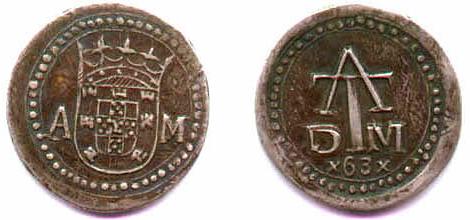
ForgeryNetwork #1094.
|
Since the coin refered to is also illustrated there
is no ambiguity that the real coin does not have x63x. Catalog
#78 is described as xx4x but that is not illustrated.
I am told that coins with x63x and xx4x have sold in leading Auctions,
which just indicates to me that some who should be experts are
sometimes misled even by stupid reproductions.
One of the aims of website website is to distribute information about Lankan
coins from older published documentation which are not readily available.
-
|
I nearly purchased a realistic EF grid-iron Tanga from a very
knowledgeable collector, but was lucky to be also offered an exact
duplicate a few days later by another dealer. They were both clearly
cast from the same mold with the identical off center design and even the
same simulated strike-like breaks along the edge. Another identical
copy also sold on ebay a few months later.
| 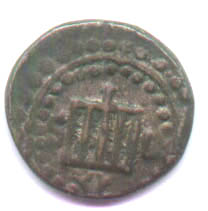 | 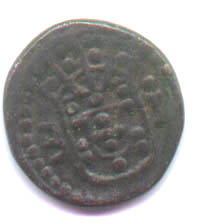
|
|
ForgeryNetwork #1095.
|
- A collector who purchased two high grade Dutch copper dumps on
ebay sent them for authentication to an expert who didn't have
encouraging words to say about them. He stated among many comments
that the patina appeared to wash away like "curry". However another
expert thought similar coins from the same seller were genuine, which
indicates that these opinions are very subjective, when dealing with
the higher quality fakes.
|
Very crude recent copies of the dutch bar coin are sold by hawkers near
the Galle
lighthouse in Lanka. See
The price depending on the gullibility
of the tourist is any price upward of US$2 (cost to hawker). The other
coins most copied are the Galle 2 and 1 Stuiver dumps, which are
manufactured not only in copper, but also in Silver :-).
The worst abuse was the so called "Dutch Museum" in Galle, which displayed
these recent copies among their coin collection, in an obvious attempt
to give credibility to perpetuate the fraud.
Please read Photo-Essay for more details.
A coin dealer in Colombo told me There are some Dutch dealers and
collectors who are presently in Sri Lanka cleaning up all the Dutch
coins available. They are probably taking back to Europe the fakes
as well :-). Too many of them are appearing on ebay Auction.
Note it is also illegal to export out of the island any genuine antigue items
including coins more than 100 years old. Technically modern fakes are
OK, but the Sri Lanka Customs Officers at Airport or Post office will not
probably identify them as such and if discovered will give you as much
problems as the genuine article untill you prove they are fake.
This is also a warning to any sellers of old coins on eBay from Lanka.
Some who have sold previously have dropped out for probably these reasons.
The risk should make it just not worth to try your luck.
| 
ForgeryNetwork #1096.
|
In 2003 the Sri Lanka Customs set up a special "Customs Public
Information Unit" on the direction of the Director General of Customs
to facilitate the detection of Customs frauds and other
malpratices. All information given to this desk is treated as
strictly confidential and is also rewarded.
Frequent advertisments in Local newspapers request the public to contact
this special unit on 24 hour Action Line on telephone number 94-11-2471471,
on smuggling of Goods with Archeological Value.
Some fakes (2 Bars and 3 Galle Stuiver dumps) very much like the crude
copies sold by hawkers Galle were put on Ebay Auction in 2000 April by
a Seller in Netherlands, who claimed his source was a dealer here
in Amsterdam who deals in Dutch artifacts pre 18th century, with a
very extensive 17th century inventory . When I explained to
seller to their identity, they were promptly withdrawn from Auction.
Soon after a much nicer Bar was listed also from Netherlands.
This seller put a link to my page as information to buyers.
and sold for just under what I paid for a similar questionable bar.
Most other sellers have withdrawn the item from Auction when informed.
One seller even agreed to gift me the forgery for my website.
In one case the seller promised to inform the winner. I found out he
had not done so, since it was not a "Private Auction". I never bid on
"Private Auction", since there is no reason for them other than the
seller wanting to hide some scam.
E-bay in general does not take action to stop those selling fake coins since
the have no expertise to know if the accusation is valid. E-bay does take
action to stop any seller who violates E-bay rules that have been setup to
protect their business interests, and can be exploited to stop sellers of
fake coins.
The typical tourist fake on left appeared on ebay auction with a start
price of $85. The seller from eastern Europe politely closed auction
when I wrote to him and admitted he had purchased it in Galle for
under $3, but assumed that he had got Lucky.
It is just amazing that when over an 100 years ago a collector Lowsley
hunted Ceylon for 4 3/4 Stuiver bars and found only one, and now
fairly nice-looking bars appears on ebay every few
months. Maybe someone has invented a time machine :-)
An amusing fake 1/12 RixDollar 1803 Elephant Dump with
CEYLON and GOVERMENT (Note N and spelling) wittten clockwise
and anti-clockwise respectively which sold on ebay.
The buyer contacted me after sale suspecting correctly that it was Junk.
It is a classic fake which reminds me of the excuse given to me by a
hawker
selling 4 3/4 copper bars made of silver in Galle, he only wanted
to earn a living selling souvenirs to the gullible tourists rather than
harm any serious collector of coins.
Another fake dump clearly from the same forgers hand appeared on
ebay on a later date. This seller when questioned pointed out that
he did say in German listing Verkauf daher ohne Obligo,
which translates to "Sale therefore without warranty".
| 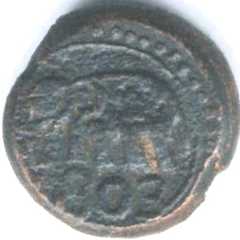 | 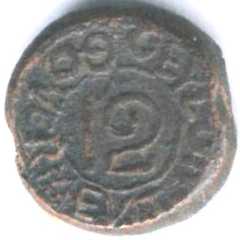
|
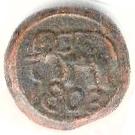 | 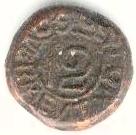
|
|
ForgeryNetwork #1099
|
Another classic set of Fake Lead coins appeared in the
colombo market in late 2006, which makes an very interesting story.
Modern Cast Replica of Early British Minted
Ceylon coins of 1802, 1815 and 1821 have also appeared in the
numismatic market in late 2007, particularly on eBay.
In 2013 CBSL when opening the new economic History Museum, had some replica massa
coins
made for sale, and a replica East India rupee
coin for display.
Buying from a knowledgeable dealer who has a good reputation of not
knowingly selling a forgery and who agrees to ( as per ANA
Dealers Code of
Ethics ) take it back without any time limits, if any are proven
to be a fake, is reasonable security. It is always useful to also
find out on what source the dealer has based the guarantee of
authenticity. If it is his/her trust of another dealer as is often the
case, then with a few such exchanges the original source is often
obscure and may be not trustworthy.
Sale or listing at a leading Auction does not make a fake reproduction
Genuine. It just makes it an interesting Fantasy. The Authority in
Lankan coins is old well researched publications such as by Codrington
which discuss mostly coins in Museum collections with documented
provenance of a discovery at an Archelogical site of that era.
As a scientist and a collector I take a conservative view and assume that
most old and particularly rare coins have a non-negligible probability
of being recent forgeries.
I personally avoid buying rare coins at a large numismatic premium.
Good Gold Coins are intrinsically worth about $12 per gram ( ~ fanam
), and silver about $6 per ounce ( ~ crown ). None of the coins in
my collection were purchased at a numismatic premium of more than $150,
and very few over $50/-. So if some turn out to be forgeries, although I
will probably never know, it is not a ridicules loss.




